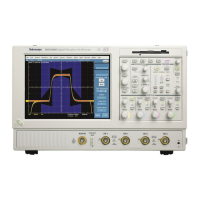TDS5000B Online Programmer Guide
-- 1 0 --
H The instrument ignores commands consisting of any combination
of white space characters and line feeds.
Abbreviating
You can abbreviate many instrument commands. Each command in this
documentation shows the abbreviations in capitals. For example, you
can enter the command ACQuire:NUMAvg simply as ACQ:NUMA or
acq:numa.
Abbreviation rules may change over time as new instrument models are
introduced. Thus, for the most robust code, use the full spelling.
If you use the HEADer command to have command headers included
as part of query responses, you can further control whether the returned
headers are abbreviated or are full--length with the VERBose command.
Concatenating
You can concatenate any combination of set commands and queries
using a semicolon (;). The instrument executes concatenated commands
in the order received.
When concatenating commands and queries, you must follow these
rules:
1. Separate completely different headers by a semicolon and by the
beginning colon on all commands except the first one. For
example, the commands TRIGger:MODe NORMal and AC-
Quire:NUMAVg 10, can be concatenated into the following single
command:
TRIGger:MODe NORMal;:ACQuire:NUMAVg 10
2. If concatenated commands have headers that differ by only the last
mnemonic, you can abbreviate the second command and eliminate
the beginning colon. For example, you can concatenate the
commands ACQuire:MODe ENVelope and ACQuire:NUMAVg 10
into a single command:
ACQuire:MODe ENVelope; NUMAVg 10
The longer version works equally well:
ACQuire:MODe ENVelope;:ACQuire:NUMAVg 10
3. Never precede a star (*) command with a colon:
ACQuire:MODe ENVelope;*OPC
Any commands that follow will be processed as if the star com-
mand was not there so the commands, ACQuire:MODe ENVe-
lope;*OPC;NUMAVg 10 will set the acquisition mode to enve-
lope and set the number of acquisitions for averaging to 10.
4. When you concatenate queries, the responses to all the queries are
concatenated into a single response message. For example, if the
display background color is white and the display foreground color
is black, the concatenated query DISplay:COLor:BACK-
Ground?;FOREGround? will return the following.

